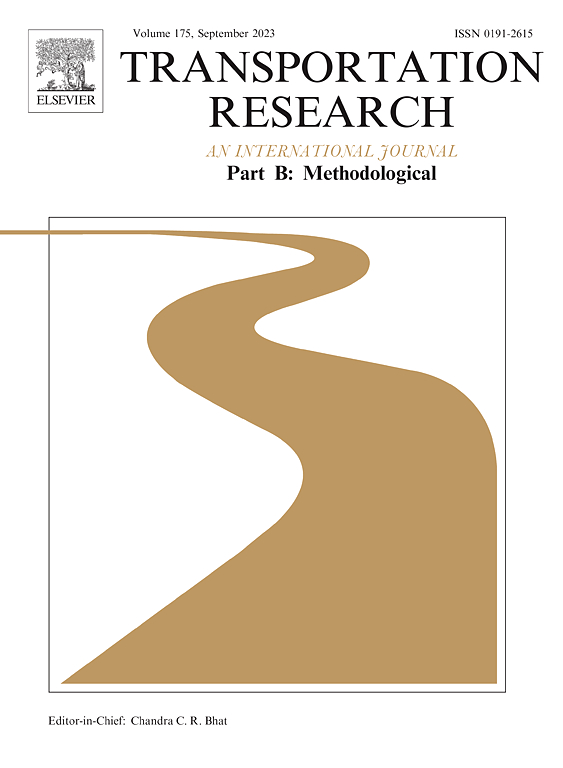Pricing in the stochastic bottleneck model with price-sensitive demand
IF 6.3
1区 工程技术
Q1 ECONOMICS
引用次数: 0
Abstract
We analyse time-varying tolling in the stochastic bottleneck model with price-sensitive demand and uncertain capacity. We find that price sensitivity and its interplay with uncertainty have important implications for the effects of tolling on travel costs, welfare and consumers. We evaluate three fully time-variant tolls and a step toll proposed in previous studies. We also consider a uniform toll, which affects overall demand but not trip timing decisions. The first fully time-variant toll is the ‘first-best’ toll, which varies non-linearly over time and results in a departure rate that also varies over time. It raises the generalised price (i.e. the sum of travel cost and toll), thus lowering demand. These outcomes differ fundamentally from those found for first-best pricing in the deterministic bottleneck model. We call the second toll ‘second-best’: it is simpler to design and implement as it maximises welfare under the constraint that the departure rate is constant over time. While a constant rate is optimal without uncertainty, it is not under uncertain capacity. Next, ‘third-best’ tolling adds the further constraint to the second-best that the generalised price should stay the same as without tolling. It attains a lower welfare and higher expected travel cost than the second-best scheme, but a lower generalised price. All our other tolls raise the price compared to the no-toll case.
In our numerical study, when there is less uncertainty: the second-best and third-best tolls achieve welfares closer to that of the first-best toll, and the three schemes become identical without uncertainty. As the degree of uncertainty falls, the uniform and single-step tolls attain higher welfare gains. Also, when demand becomes more price-sensitive, the uniform and single-step tolls attain relatively higher welfare gains. Our step toll would lower the generalised price without uncertainty but raises it in our stochastic setting.
具有价格敏感需求的随机瓶颈模型中的定价
本文分析了具有价格敏感需求和不确定容量的随机瓶颈模型中的时变收费问题。我们发现,价格敏感性及其与不确定性的相互作用对通行费对旅行成本、福利和消费者的影响具有重要意义。我们评估了三种完全时变收费和先前研究中提出的阶梯收费。我们还考虑统一收费,它会影响总体需求,但不会影响出行时间的决定。第一个完全时变收费是“第一最佳”收费,它随时间非线性变化,导致出车率也随时间变化。它提高了一般价格(即旅行成本和通行费的总和),从而降低了需求。这些结果与确定性瓶颈模型中最优定价的结果根本不同。我们称第二收费为“次优收费”:它更容易设计和实施,因为它在出站率随时间不变的约束下使福利最大化。在不确定的情况下,恒速率是最优的,但在容量不确定的情况下,恒速率是最优的。其次,“第三优”收费给第二优增加了进一步的约束,即一般价格应与不收费时保持不变。与次优方案相比,该方案的福利较低,预期出行成本较高,但总体价格较低。与不收费的情况相比,我们所有其他收费都提高了价格。在我们的数值研究中,当不确定性较小时:第二最佳和第三最佳收费获得的福利更接近第一最佳收费,并且三种方案在没有不确定性的情况下变得相同。随着不确定性程度的降低,统一和单步收费获得更高的福利收益。此外,当需求对价格更加敏感时,统一和单一步骤的通行费获得相对较高的福利收益。我们的步长收费会在没有不确定性的情况下降低一般价格,但会在随机设置中提高一般价格。
本文章由计算机程序翻译,如有差异,请以英文原文为准。
求助全文
约1分钟内获得全文
求助全文
来源期刊
CiteScore
12.40
自引率
8.80%
发文量
143
审稿时长
14.1 weeks
期刊介绍:
Transportation Research: Part B publishes papers on all methodological aspects of the subject, particularly those that require mathematical analysis. The general theme of the journal is the development and solution of problems that are adequately motivated to deal with important aspects of the design and/or analysis of transportation systems. Areas covered include: traffic flow; design and analysis of transportation networks; control and scheduling; optimization; queuing theory; logistics; supply chains; development and application of statistical, econometric and mathematical models to address transportation problems; cost models; pricing and/or investment; traveler or shipper behavior; cost-benefit methodologies.

 求助内容:
求助内容: 应助结果提醒方式:
应助结果提醒方式:


